| Cycloped | |||||||
|---|---|---|---|---|---|---|---|
 Contemporary drawing of Cycloped | |||||||
| |||||||
| |||||||
Cycloped was an early horse-powered locomotive, built by Thomas Shaw Brandreth of Liverpool, which competed unsuccessfully in the Rainhill trials of October 1829.
| Cycloped | |||||||
|---|---|---|---|---|---|---|---|
 Contemporary drawing of Cycloped | |||||||
| |||||||
| |||||||
Cycloped was an early horse-powered locomotive, built by Thomas Shaw Brandreth of Liverpool, which competed unsuccessfully in the Rainhill trials of October 1829.
The Cycloped was the only entry in the trials that did not rely on steam power, instead utilising a treadmill that was kept continually moving by a horse mounted on top.
Brandreth was one of the directors of the railway and some people believed that that gave the Cycloped an unfair advantage. But the Cycloped was an impractical idea and because of its failure to generate enough speed to equal its competitors—Burstall's Perseverance, Braithwaite's Novelty, Hackworth's Sans Pareil and Stephenson's Rocket —it ultimately lost the competition in the trials. [1] Stephenson's Rocket eventually won the trials, maintaining an average speed of 13.8 mph (22.2 km/h) for a modest consumption of coal and water.
Horses had been used to pull wagons on coal and mineral tramways and plateways for some years before this. Many of these tramways and plateways were arranged so that the line ran downhill from the mine to a river or coastal port. Loaded trains would descend under the power of gravity, with horses used to haul the empty trains back uphill.
Early examples with just one or two wagons together were pulled downhill by the horse, the horse also acting as brakes.[ citation needed ] Once improved mechanical brakes were available, longer trains of wagons could be controlled during their descent. The horses were carried downhill in a special dandy wagon, usually attached to the end of the run of loaded wagons. These dandy wagons were simple unpowered wagons, often with no more adaptation for horses than special doors to load and unload the animals.

Horse locomotives were only used for a brief period between the development of passenger-carrying public railways and the provision of viable steam locomotives. Other horse-powered locomotives include the Flying Dutchman of the South Carolina Canal and Railroad Company, used briefly in 1830, and the Impulsoria , exhibited at the Great Exhibition in 1851.

A locomotive or engine is a rail transport vehicle that provides the motive power for a train. If a locomotive is capable of carrying a payload, it is usually rather referred to as a multiple unit, motor coach, railcar or power car; the use of these self-propelled vehicles is increasingly common for passenger trains, but rare for freight trains.

The Rainhill trials was an important competition run from the 6 to 14 October 1829, to test George Stephenson's argument that locomotives would have the best motive power for the then nearly-completed Liverpool and Manchester Railway (L&MR). Ten locomotives were entered, of which five were able to compete, running along a 1 mile (1.6 km) length of level track at Rainhill, in Lancashire.

Stephenson's Rocket is an early steam locomotive of 0-2-2 wheel arrangement. It was built for and won the Rainhill Trials of the Liverpool and Manchester Railway (L&MR), held in October 1829 to show that improved locomotives would be more efficient than stationary steam engines.

Wagonways, also known as horse-drawn railways and horse-drawn railroad consisted of the horses, equipment and tracks used for hauling wagons, which preceded steam-powered railways. The terms plateway, tramway, dramway, were used. The advantage of wagonways was that far bigger loads could be transported with the same power.
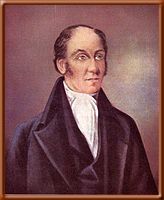
Timothy Hackworth was an English steam locomotive engineer who lived in Shildon, County Durham, England and was the first locomotive superintendent of the Stockton and Darlington Railway.
The Leicester and Swannington Railway (L&SR) was one of England's first railways, built to bring coal from West Leicestershire collieries to Leicester, where there was great industrial demand for coal. The line opened in 1832, and included a tunnel over a mile in length, and two rope-worked inclined planes; elsewhere it was locomotive-operated, and it carried passengers.
Transportation of goods to factories, and of finished products from them, was limited by high transport costs along roads to their destinations. This was not too severe in the case of light valuable materials such as textiles but in the case of dense materials such as coal, it could be a limiting factor on the viability of an industry. In contrast, freighting goods by water, whether on rivers or coastwise was much cheaper. Canals brought the first major change to transportation, and were usually built directly from the mines to city centres, such as the famous Bridgewater Canal in Manchester. Tramways were also common using horses locomotion.
A gravity railroad or gravity railway is a railroad on a slope that allows cars carrying minerals or passengers to coast down the slope by the force of gravity alone. The speed of the cars is controlled by a braking mechanism on one or more cars on the train. The cars are then hauled back up the slope using animal power, a locomotive or a stationary engine and a cable, a chain or one or more wide, flat iron bands. A much later example in California used 4 ft 8+1⁄2 instandard gauge steam engines to pull gravity cars back to the summit of Mt. Tamalpais.
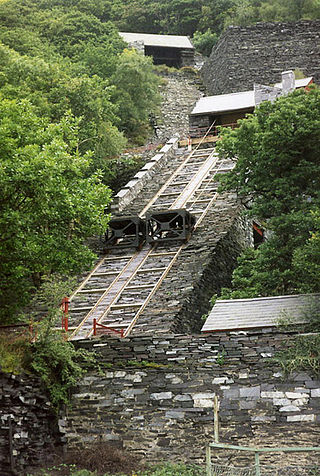
A cable railway is a railway that uses a cable, rope or chain to haul trains. It is a specific type of cable transportation.

An 0-2-2, in the Whyte notation for the classification of steam locomotives by wheel arrangement, is one that has two coupled driving wheels followed by two trailing wheels, with no leading wheels. The configuration was briefly built by Robert Stephenson and Company for the Liverpool and Manchester Railway.

Novelty was an early steam locomotive built by John Ericsson and John Braithwaite to take part in the Rainhill Trials in 1829.
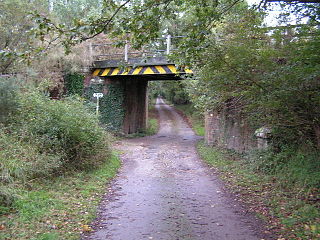
The Furzebrook Railway, also known as the Pike Brothers' Tramway, was a narrow gauge industrial railway on the Isle of Purbeck in the English county of Dorset. It was built by the Pike Brothers, to take Purbeck Ball Clay from their clay pits near Furzebrook and West Creech to a wharf at Ridge on the River Frome.
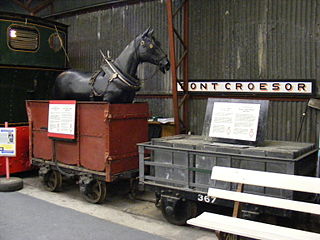
The dandy waggon is a type of railway carriage used to carry horses on gravity trains. They are particularly associated with the narrow gauge Festiniog Railway (FR) in Wales where they were used between 1836 and 1863.
The history of rail transport in Great Britain to 1830 covers the period up to the opening of the Liverpool and Manchester Railway, the world's first intercity passenger railway operated solely by steam locomotives. The earliest form of railways, horse-drawn wagonways, originated in Germany in the 16th century. Soon wagonways were also built in Britain. However, the first use of steam locomotives was in Wales. The invention of wrought iron rails, together with Richard Trevithick's pioneering steam locomotive meant that Britain had the first modern railways in the world.
Thomas Shaw Brandreth, FRS was an English mathematician, inventor and classicist.

The Adler was the first locomotive that was successfully used commercially for the rail transport of passengers and goods in Germany. The railway vehicle was designed and built in 1835 by the British railway pioneers George and Robert Stephenson in the English city of Newcastle. It was delivered to the Bavarian Ludwig Railway for service between Nuremberg and Fürth. It ran officially for the first time there on 7 December 1835. The Adler was a steam locomotive of the Patentee type with a wheel arrangement of 2-2-2 or 1A1. The Adler was equipped with a tender of type 2 T 2. It had a sister locomotive, the Pfeil.

A mine railway, sometimes pit railway, is a railway constructed to carry materials and workers in and out of a mine. Materials transported typically include ore, coal and overburden. It is little remembered, but the mix of heavy and bulky materials which had to be hauled into and out of mines gave rise to the first several generations of railways, at first made of wooden rails, but eventually adding protective iron, steam locomotion by fixed engines and the earliest commercial steam locomotives, all in and around the works around mines.

The Liverpool and Manchester Railway (L&M) opened on 15 September 1830. Work on the L&M had begun in the 1820s, to connect the textile mills of the city of Manchester with the nearest deep water port at the Port of Liverpool, 35 miles (56 km) away. Although horse-drawn railways already existed elsewhere, the Stockton and Darlington Railway had been running for five years, and a few industrial sites already used primitive steam locomotives for bulk haulage, the L&M was the first locomotive-hauled railway to connect two major cities, and the first to provide a scheduled passenger service. The opening day was a major public event. Arthur Wellesley, Duke of Wellington, the prime minister, rode on one of the eight inaugural trains, as did many other dignitaries and notable figures of the day. Huge crowds lined the track at Liverpool to watch the trains depart for Manchester.
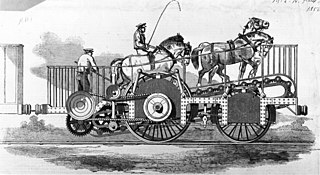
The Impulsoria was a locomotive constructed in 1850 that was powered via a gearbox by two to four horses on a treadmill following a design by Clemente Masserano. It undertook trials in London in 1850 and was exhibited at The Great Exhibition in 1851.